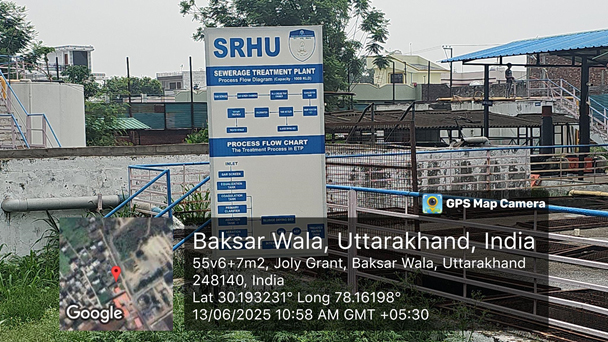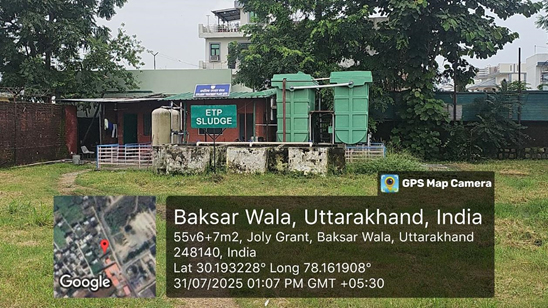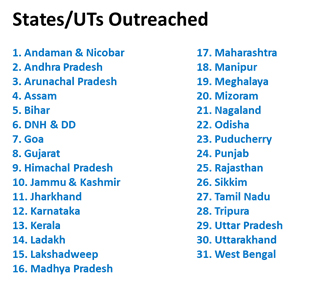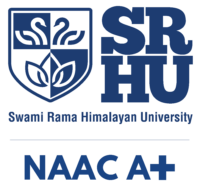Water Conservation
September 23, 2025 2025-10-24 11:04Water Conservation
Water Conservation
Swami Rama Himalayan University (SRHU) is actively contributing to the achievement of clean water and sanitation through a range of innovative, educational, and community-based initiatives. Recognizing the global challenges associated with water scarcity, pollution, inadequate infrastructure, and governance issues, SRHU is committed to addressing these problems through sustainable practices, research, and awareness.
At SRHU, a robust set of water conservation initiatives is in place, aimed at reducing water usage, enhancing sustainability, and preserving precious water resources for future generations. The university has implemented strategies such as rainwater harvesting, groundwater recharging, installation of waterless urinals, and innovative approaches to water usage in toilets and other facilities.
Institutional Water Infrastructure & Conservation
SRHU has operated a dedicated Water & Sanitation (WATSAN) Department since 1998 (over 26 years), steadfast in advancing sustainable water, sanitation, and hygiene (WASH) interventions to improve public health outcomes. These efforts have positively impacted over 200 villages across Uttarakhand, empowering communities to take ownership of WASH initiatives.
Key Projects Implemented under SRHU’s RDI
- A dedicated Water & Sanitation Resource Centre, supported by IRC, Netherlands
- Participation in the Swajal Sector Reform Program (SWAp)
- Implementation of the Himmothan Pariyojana, in collaboration with Tata-Titan and the Hans Foundation
- Execution of Nirmal Bharat Abhiyan / Total Sanitation Campaign
- Contributions to the Urban Sector Development Investment Program
National Recognition
Through its flagship institution—the Himalayan Institute Hospital Trust (HIHT)—SRHU has earned national recognition. The Ministry of Jal Shakti, Government of India, has empaneled HIHT to undertake Corporate Social Responsibility (CSR) projects, placing it at the 4th rank nationally and as the only organization from Uttarakhand on the list. Additionally, HIHT has been designated as a National Key Resource Center (NKRC) under the Swachh Bharat Mission (Gramin), underscoring SRHU’s leadership in strengthening rural WASH systems in alignment with national priorities.

WATSAN department at Swami Rama Himalayan University

Accomplishments of WATSAN under clean water and sanitation


Major themes and functional areas covered by WATSAN
Rainwater Harvesting and Groundwater Recharge
Rainwater Harvesting and Groundwater Recharge
SRHU benefits from an annual rainfall of 2073.3 mm, which is harnessed through a well-planned rainwater harvesting system. The rainwater collected from rooftops, paved roads, open areas and green belts across the campus contributes significantly to water conservation. This brings the total annual volume of rainwater available for harvesting to 3,77,892.7 cubic meters. To complement this, the university has constructed 13 recharge pits and 2 borewell recharge structures, contributing to 796.73 cubic meters of groundwater recharging.
Rainwater harvesting is implemented extensively across the campus with a blend of traditional engineering and modern filtration systems. A series of recharge pits and filter beds have been constructed across academic and residential zones. The harvested rainwater is stored in underground tanks, used for flushing, cleaning, and groundwater recharge, significantly reducing the need for extracted groundwater.

- Total rainwater harvesting capacity: 40 crore liters
- Underground tank capacity: 1.5 lakh liters
- Daily reuse from tank: 3,000 liters for 111 toilets & 138 taps
- Total rooftop area utilized: 9,000 sq. meters
- Annual groundwater recharge from harvested water: 1.57 crore liters
- Rainwater used for flushing and cleaning: 9.45 lakh liters/year
- Key recharge pit specifications:
- Guest House Area: 3 pits with filter beds (6.42×2×1.5 m), recharge depth: 6 m
- New OPD Zone: Multiple pits of 3 m diameter × 12 m depth
- Medical College (SBI Bank): Filtration system with recharge pit of 3 m diameter × 3.35 m depth

Rainwater harvesting is implemented across the campus: pit at SRHU

Rainwater harvesting pit near New Block

Underground water tank at SRHU

Recharge pit near University Office
Wastewater Treatment & Reuse
Wastewater Treatment & Reuse
The University has established a comprehensive and environmentally responsible wastewater management framework to ensure the safe treatment, recycling, and reuse of both domestic sewage and industrial effluents. These efforts contribute significantly to water conservation, public health, and environmental sustainability on campus.
Sewage Treatment Plant (STP)
- Capacity: 1 MLD (10,00,000 litres/day)
- Technology: Moving Bed Biofilm Reactor (MBBR) with extended aeration and tertiary filtration
- Construction Cost: ₹1.25 crore
- Daily Average Treatment: 7,00,000 litres
Water Reuse
9,43,153 litres recycled annually for:
- Green belt irrigation (1,60,800 sqm)
- Construction activities
- Vehicle washing
Water flow meter monitoring system from inlet & outlet ensures efficiency. Recycling of water from STP aligns with Sustainable Development Goals (SDGs).
Additional Sustainability Measures
- Manure Use: Sludge from STP is processed and reused as organic manure in campus landscaping.
- Monitoring: Treated water tested biannually at NABL-accredited labs. Recent results within norms (pH: 7.15, BOD: 9 mg/L, COD: 39.7 mg/L, Fecal Coliform: <80 MPN/100ml).
- Compliance: Fully adheres to State Pollution Control Board regulations.

Water flow meter monitoring system from water inlet and outlet

Recycling of water from STP aligns with Sustainable Development Goals
Effluent Treatment Plant
Effluent Treatment Plant (ETP)
- Capacity: 90,000 litres/day
- Purpose: Designed for treating clinical and laboratory effluents from hospital and research units
Process Highlights
- Equalization, coagulation, neutralization, aeration, clarification
- Tertiary treatment via sand and activated carbon filters
- Continuous aeration and regular sludge handling
Sludge Disposal
Managed in partnership with M/S Bharat Oil & Waste Management Ltd, approved by UEPPCB, ensuring safe and compliant disposal practices.
Safety & Compliance
- Daily operational monitoring: pH (7–8), chlorine levels (1–2 mg/L)
- Equipment checks and filter backwashing every 4–8 hours
- Treated water reused internally for non-potable purposes

Effluent Treatment Plant at SRHU for treatment of clinical and laboratory effluent

Effluent Treatment Plant at SRHU for treatment of clinical and laboratory effluent

Routine Testing report of effluent discharged from ETP
Operational Excellence & Environmental Stewardship
Both STP and ETP systems are maintained through detailed SOPs ensuring uninterrupted functioning, proper sludge handling, and minimal environmental discharge. Air blowers, dosing pumps, and filtration systems are operated under rigorous schedules by trained operators, supervised by the Engineering & Maintenance (E&M) team. Preventive maintenance and strict quality checks ensure high efficiency and regulatory compliance.
Water-Saving Sanitation Features
Water-Saving Sanitation Features
In addition to robust wastewater treatment and rainwater harvesting systems,
Swami Rama Himalayan University (SRHU) has implemented a series of innovative, low-cost,
and high-impact interventions to reduce freshwater consumption across its academic, residential,
and clinical zones.
Waterless Sanitation Solutions
Installation of over 150 waterless urinals across campus has significantly reduced the need for flushing,
saving approximately 1.5 lakh litres per urinal annually, resulting in a total annual saving of
2.25 crore litres of water.
Waterless urinals present at different locations across the University
Reuse of Condensed AC Water
Condensate water from air conditioning units is systematically collected and repurposed,
contributing to 1.2 lakh litres of water saved annually—an innovative reuse strategy
supporting sustainable water use.
Condensed water from AC Units is used across the campus to repurpose and recycle water
Recycling of RO Reject Water
RO (Reverse Osmosis) reject water, which is often discarded, is now being utilized effectively for
toilet flushing and laundry, leading to annual savings of approximately 32.85 lakh litres.
Sensor-Based Scrub Stations
Sensor-Based Scrub Stations
SRHU has deployed sensor-activated scrub stations in its Operation Theatres (OTs), which minimize water wastage during hand scrubbing. This smart technology helps save approximately 5 lakh litres of water per year, contributing to the University’s sustainable water management practices.

Sensor activated scrub station aiding in water conservation
Community Outreach and Training
Community Outreach and Training
Beyond its campus operations, SRHU actively contributes to regional water sustainability by supporting community water access and building institutional capacities. The university has facilitated the construction of water conservation tanks in remote villages and provides training to stakeholders across India under national water management programs.
- Villages supported with clean water infrastructure: 550+
- Conservation tanks constructed: 600+ units (7,000-liter capacity each)
- Stakeholders trained through national programs: 7,787
- Functional areas covered: aquifer recharge, greywater management, spring restoration
- Hands-on environmental education: Integrated into undergraduate curricula through STP visits

States and Union territories covered by WATSAN, SRHU supporting SDG 6

Participation by WATSAN in various national and local relevant programmes

Snippets of various activities under WATSAN translating into clean water and sanitation
Environmental and Social Audit under the Namami Gange Programme
Environmental and Social Audit under the Namami Gange Programme
Swami Rama Himalayan University (SRHU) has been engaged as a key evaluator in the Government of India’s Namami Gange Programme, an initiative launched in 2014 to address pollution in the Ganga River. Recognizing the river’s ecological, cultural, and economic importance, SRHU conducts Environmental and Social Audits to assess the performance and community impact of pollution abatement interventions.
SRHU has been entrusted by the State Mission for Clean Ganga (SMCG), Government of Uttarakhand, to conduct comprehensive audits of STPs and Interception & Diversion (I&D) units in nine locations across the districts of Haridwar, Tehri, Dehradun, and Nainital. These audits ensure that interventions comply with sustainability frameworks and maximize community benefits.

STP under Namami Gange Initiative

STP monitoring and Audit under Namami Gange

Sensitization of masses on importance of clean water under Namami Gange
Research, Innovation, and Policy Integration
Research, Innovation, and Policy Integration
Swami Rama Himalayan University (SRHU) promotes research-driven solutions for water reuse and conservation. Research projects, patents, and publications reflect the university’s academic commitment to developing low-cost, scalable technologies. Water management policies guide the campus community in source segregation, compliant disposal, and safe reuse of wastewater.
Number of patents in water technology: 3 (including rooftop harvester and direct injection system)
As part of its commitment to sustainable development and water security, SRHU initiated the project “Affordable Climate-resilient Water Supply Infrastructure for the Indian Himalayan Region”. The project focuses on low-cost, climate-resilient, prefabricated source tapping and filtration systems, piloted in a mountain village and intended for scaling across vulnerable geographies.

Design Drawing for low-cost, climate-resilient, and prefabricated source tapping and filtration system

Water being collected post installation of low-cost underground water filtration
SRHU provides intramural research funding for projects aligned with SDG 6. Notable projects include:
| S. No. | Project Name | Duration | Faculty |
|---|---|---|---|
| 1 | Upgrading plant microbe-based approach to enhance phytoremediation method in contaminated water body | 1 year | Dr Vivek Kumar |
| 2 | Water quality assessment in a selected Urban Slum of Doiwala Block in district Dehradun | 1 year | Dr. Abhay Srivastava |
SRHU has addressed critical challenges such as water quality monitoring, wastewater management, bioremediation, and groundwater safety. The following Scopus-indexed publications reflect evidence-based approaches to improving access to clean water and sustainable environmental stewardship:
| SN | Publication Title | DOI |
|---|---|---|
| 1 | Mapping of radionuclides for radiological impact assessment in cultivated soil of Punjab, India | 10.1016/j.apradiso.2025.111881 |
| 2 | Spatial distribution analysis of soil radioactivity using gamma-ray spectroscopy and radiological inferences | 10.1140/epjs/s11734-025-01645-5 |
| 3 | Hospital-associated effluents: the masked environmental threat that needs urgent attention and action | 10.1007/s42452-024-06456-2 |
| 4 | Study of radiation exposure to radon in groundwater using scintillation-based RnDuo technique: A statistical analysis for risk assessment | 10.1016/j.apradiso.2025.111789 |
| 5 | Environmental restoration of polyaromatic hydrocarbon-contaminated soil through sustainable rhizoremediation | 10.1039/d4va00203b |
| 6 | Assessment of soil gas radon migration and transport through the estimation of radon diffusion length and diffusion coefficient in the soil matrix | 10.1016/j.net.2024.11.007 |
| 7 | Measurement of natural radionuclides and health risk assessment in soil samples of the Main Central Thrust region in Garhwal Himalaya, India | 10.1007/s10661-024-13569-z |
| 8 | Spatial analysis and soft computational modeling for hazard assessment of potential toxic elements in potable groundwater | 10.1038/s41598-024-76147-w |
| 9 | Impact of Artificial Intelligence (AI) in Bioremediation of Dairy Effluent by Microalgae and the Potential Application of the Produced Lipid Byproducts | 10.1002/9781394272266.ch11 |
| 10 | Appropriate Hand Drying – The Missed Step of Hand Hygiene: A Qualitative Evaluation of Hand Drying Practices among Indian Health Care Workers | 10.4103/ijcm.ijcm_667_22 |



